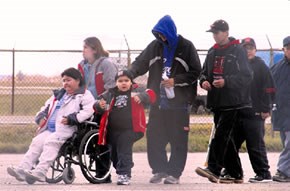While the contingency planning started a month ago, it’s still
too soon to say whether evacuees from the flood-threatened
communities along the James Bay coastline will seek shelter in
Greater Sudbury.
“We haven’t received a request from the province to send them to Sudbury,” says Ghislain Lamothe, manager of corporate communications and French-language services for the city. “Right now, it’s just been two or three other communities that have been receiving them.”
City officials are communicating with Emergency Measures Ontario
(EMO) and Indian and Northern Affairs Canada (INAC) daily about any
new developments. If the need arises to bring evacuees here,
the city will be given 48-hours notice to make any last-minute
arrangements and to ensure the accommodations and services needed
are in place.
“Normally in a flooding situation, (the evacuees) are in a host
community for four to nine days maximum, and that includes
transport in and transport out, so they’re here for a short period
of time,” says Alan Stephen, the city’s general manager of
infrastructure and emergency services.
“This is a life and limb situation to get people out for their
safety and security and then they go back in as soon as they
can.”
After declaring a state of emergency Saturday, the first James
Bay community to be evacuated because of flooding was the
Kashechewan First Nation Reserve.
According to EMO representative Bruce O’Neill, close to 1,000
people have already been transported from Kashechewan, with more
expected to leave Tuesday.
“We’re in the process of evacuating more people out of there
today (Tuesday),” O’Neill says. “We got out 966, as of the end of
yesterday, and we’re anticipating getting out approximately 150 or
so more.”
Evacuees have been taken to Thunder Bay, Kapuskasing, and
Cochrane, while three planeloads that left Tuesday will be directed
to Greenstone.
This is the third time in a year the members of the beleaguered
reserve have had to flee their homes because of water-related
threats. Last spring, the community was forced out because of
flooding. In October, around 1,000 residents sought shelter in
communities across Northern Ontario due to unsafe drinking water;
more than 250 of those residents were evacuated to Sudbury, where
they stayed in community arenas and then hotels for around two
months.
On top of the trauma of being forced out of their homes, the
community has also had to deal with the horrific deaths of three
community members. In January, two men in police custody were
killed when the jail caught on fire. The substandard
condition of the jail, including faulty jail locks, was alleged to
be a factor in the deaths. Earlier this month, a
four-year-old girl perished in a house fire. Twenty-one people
lived in the home at the time, which is indicative of the
inadequate housing situation on the reserve. Both fires are still
under investigation.
In a media release issued yesterday, Nishnawbe Aski Nation (NAN)
Grand Chief Stan Beardy called for the government of Ontario and
Canada to commit to finding solutions on how to improve living
conditions on the reserve.
“After three evacuations in one year, it’s time to address the
root causes forcing the residents out of their homes,” Beardy
says.
“It’s just not normal to be displaced from your home three times
in one year – it affects everyone from the children to the
elders.
“It’s time for the Conservatives to back what was agreed to by
the former government and acknowledge the situation in Kashechewan
by implementing mechanisms and strategies to meet basic human needs
on a long-term basis.”
Beardy and Kashechewan First Nation Chief Leo Friday have a
meeting scheduled for May 3 with Minister of Indian and Northern
Affairs Jim Prentice to discuss the escalating issues at the remote
native reserve.
As the Kashechewan evacuation continues, some residents are
choosing not to leave even though there hasn’t been municipal water
available since Saturday and the power is expected to be cut off
soon because of the threat of rising water levels.
“Some residents are indicating they don’t want to go,” O’Neill says.
“It’s up to the community leaders to co-ordinate that and tell
us who is going and we just fill the planes.”
As well, evacuation efforts began yesterday in the community of
Fort Albany, which also declared a state of emergency on Saturday
but didn’t immediately request to be evacuated.
“They had put their request to be evacuated on hold, but this
morning (Tuesday) the chief has asked that 350 be evacuated, and
we’ll be doing that today,” O’Neill says.
The community of Attawapiskat is also facing severe flooding,
but hadn’t declared a state of emergency as of Tuesday
afternoon.
Even with the latest evacuation from Fort Albany, Sudbury won’t
be receiving any evacuees and will continue to remain on
standby.
“Sudbury is not on the radar at this point,” O’Neill
says.
However, if the need arises, Stephen says the city has agreed to
accept 250 evacuees, but depending on the severity of the
evacuation, the capability is there to take in many more. As with
the evacuation in October, shelter would be provided at the Capreol
Millenium Centre and arena.
The city is better prepared to handle this type of situation
this time around. Stephen says the biggest lessons learned
last fall were the need for communication between the city and
evacuating community and understanding the needs and requirements
of the people evacuated.
As for the $1.8 million bill from the last evacuation, Stephen says the federal government has nearly paid it off, with only around $80,000-86,000 outstanding.
